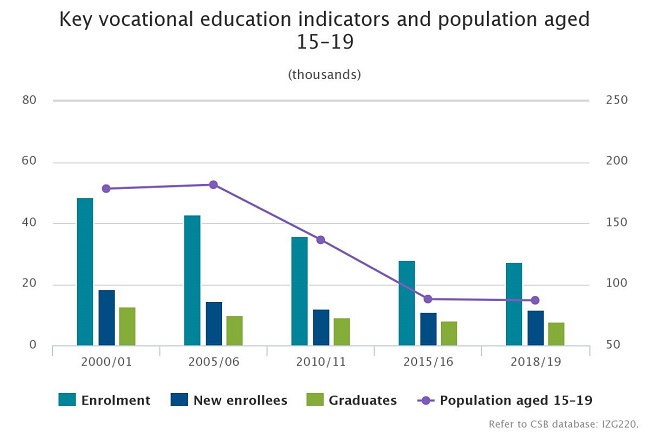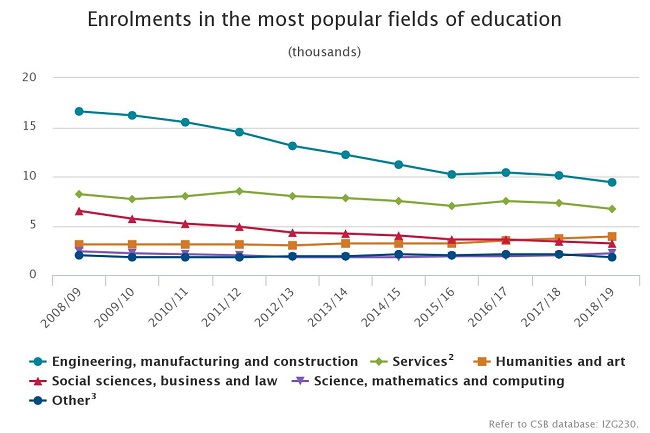Analytics, Education and Science, Latvia, Statistics
International Internet Magazine. Baltic States news & analytics
Friday, 26.04.2024, 01:51
Decline in vocational education enrolments in Latvia
 Print version
Print versionThis school year, vocational education programmes were entered by 11.7 thousand new students, which is 55 students more than a year ago. Engineering, manufacturing and construction as well as services programmes were the most popular ones. These fields of education were chosen by 32.9% and 26.6% entrants, respectively. Within the engineering, manufacturing and construction field, engineering and engineering trades (35.4%), building and civil engineering (23.9%), as well as mechanics and metal work (14.7%) were the most popular programmes. Within the services field, the greatest number of entrants was recorded in the programmes of hotel, restaurant and catering (59.3%) and hair and beauty services (25.8%). Over the past years, increase may be observed in the share of entrants aged over 30 – 11% in the school year 2018/2019, 10% two years ago, and 3.6 % in the school year 2010/2011.
The number of graduates with degree or qualification has not changed significantly for the third year in a row and constitutes 7.7 thousand (7.8 thousand last year). Out of the graduate number, 2.6 thousand students or more than one third of the graduates acquired qualification in engineering, manufacturing and construction, while 2.1 thousand or 27% in services programmes (including 1.3 thousand in hotel, restaurant and catering). However, it should be noted that the total number of vocational education graduates has dropped by 15.6% since 2010. The main reason behind the downturn lies in the sharp reduction – of 36% – in the number of young people aged 15–19.

The greatest vocational education enrolments were recorded in engineering, manufacturing and construction (9.4 thousand) and services2 fields (6.7 thousand), comprising 34.6% and 24.7% of the total enrolments, respectively. Humanities and arts enrolments are gradually growing as well – rise of almost 24% over a five-year period. In this school year, humanities and arts programmes are acquired by 3.9 thousand students, accounting for 14.4% of the total vocational education enrolments. Social sciences, business and law are acquired by 11.8% of students, while science, mathematics and computing by 8%. The lowest enrolments still may be observed in agriculture and veterinary (3.3%) as well as health and welfare (3.2%) programmes.

Regardless vocational education has always been more popular among males, the data show that the share of females in vocational education is growing every year. In the school year 2010/2011 the share of males in vocational education enrolments accounted for 60.2%, while in 2018/2019 for 54.7%.
Almost just like the year before, vocational education programmes are implemented in 46 vocational educational institutions, 11 colleges, and 2 general schools. Almost one third of the enrolments have entered five of the largest vocational education institutions: Riga State Technical School, Riga Technical School of Tourism and Creative Industry, Liepaja State Technical School, Daugavpils Construction Technical School, and Riga Technical College.








 «The Baltic Course» Is Sold and Stays in Business!
«The Baltic Course» Is Sold and Stays in Business!

